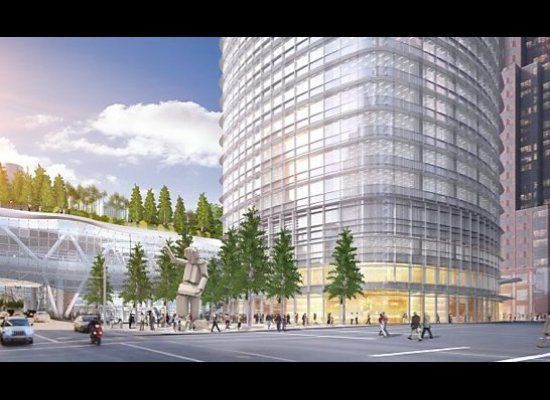
SAN FRANCISCO -- Starry-eyed city leaders boast that the $4.2 billion Transbay Transit Center planned for South of Market will include the tallest building on the West Coast, but they've left out one crucial detail: a tower in Los Angeles that is poised to stretch 30 feet higher.
Mayor Ed Lee and other city officials this week celebrated the $192 million acquisition of a property at the corner of First and Mission streets where two developers will erect the 1,070-foot-tall Transbay Transit Tower by 2017. The office tower will become the tallest building in San Francisco, eclipsing the iconic Transamerica Pyramid, built in 1972.
But the elegantly tapered skyscraper's western dominion will apparently be short-lived, if it ever comes to pass. Korean Air is planning an ambitious hotel and office tower in downtown Los Angeles that will rise 1,100 feet, including a 100-foot stainless steel spire. The new Wilshire Grand is also slated to open in 2017.
Nonetheless, Lee joined the Transbay Joint Power Authority on Tuesday in touting the supremacy of the Transbay tower, which will soar above a new transportation hub supporting 11 transit systems and a micro-neighborhood with 2,600 residential units.
"Soon to be the West Coast's tallest building," Lee crowed in a statement, "the Transbay tower benefits not only a world-class transit facility but also represents the strength of our city's recovery."
Asked repeatedly about the Wilshire Grand, the communications team for the Transbay Joint Powers Authority at first ignored the question, then threw a knuckle ball. Spokesman Adam Alberti said a "superstructure" of some kind will be added to the Transbay tower that will likely bring it above 1,100 feet, though fact sheets and renderings do not indicate such a feature.
Alberti finally downplayed the whole issue of height, saying the authority doesn't want bragging rights, just a well-conceived project: "If that ends up with us having the second-tallest tower in the west by some standards, I don't think anyone will lose sleep over it."
The mayor's office did not respond Friday to a request for comment.
Counting spires
Though some San Francisco boosters might cry foul over the Wilshire Grand's spire, the Council on Tall Buildings and Urban Habitat, a nonprofit that describes itself as the world's leading authority on tall buildings, would disagree. The council considers spires to be fair game when calculating building heights, and claims this is the most widely accepted method for measuring high rises.
Interestingly, the architects who designed the Wilshire Grand use a different criterion for the height of their 73-story creation: highest occupied floor. By that measure the Wilshire Grand would still top the 60-floor Transbay tower, but it wouldn't even be the tallest building in Los Angeles. That title would remain with the U.S. Bank Tower, a 1,018-foot cylinder that reigns as the highest building west of the Mississippi River.
Being the tallest edifice in the western United States is hardly a glowing distinction. More than a century after the first U.S. skyscrapers were erected in New York City and Chicago, most are still built east of the Mississippi. Of the 100 tallest buildings in America, only 11 are situated on the West Coast, according to the Council on Tall Buildings.
Moreover, the United States has passed the baton of skyscraper mania to the Middle East and Asia, where a boom in "supertall" buildings -- those above 600 meters, or 984 feet, in height -- is well under way. The world's tallest building, the Burj Khalifa in Dubai, rises 2,717 feet, more than twice as high as the Empire State Building.
Culture and climate
Skyscrapers used to proclaim the worth of the corporations that built them, said Anthony Wood, executive director of the Council on Tall Buildings. These days they serve the same purpose for cities in developing regions of the world. "They are using supertall buildings to brand themselves as progressive, developed cities in a competitive global market," Wood said.
That need for recognition is absent in cosmopolitan San Francisco, which has broken with decades of tradition in allowing a building above 1,000 feet. The city enacted policies in the 1980s that restrict high-rise development. There is now an annual cap on new office space, and all buildings over 40 stories are analyzed to determine whether they cast shadows on parks.
These policies are indicative of differences in culture, climate and commercial real estate markets that have prevented San Francisco and other western cities from fully embracing the East Coast's drive to build skyscrapers, said Mary Comerio, a professor of architecture at UC Berkeley.
Development in California has traditionally been more horizontal than vertical, Comerio said. Many leading technology companies in the Bay Area have chosen suburban campuses over urban towers.
"In California people want to walk outside and see a tree," Comerio said. "In New York, who cares if you're in a high rise? It's miserable eight months of the year."
Contact Aaron Kinney at 650-348-4357. Follow him at Twitter.com/kinneytimes. ___
(c)2013 the San Mateo County Times (San Mateo, Calif.)
Visit the San Mateo County Times (San Mateo, Calif.) at www.mercurynews.com/san-mateo-county
Distributed by MCT Information Services
